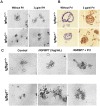Loss of Igfbp7 causes precocious involution in lactating mouse mammary gland
- PMID: 24505323
- PMCID: PMC3913705
- DOI: 10.1371/journal.pone.0087858
Loss of Igfbp7 causes precocious involution in lactating mouse mammary gland
Abstract
Background: Insulin like growth factors (IGFs) and their binding proteins (IGFBPs) are secreted peptides that play major roles in regulating the normal development and maturation of mammary gland. While Igfbp7 has been shown to decrease breast tumor growth, its role in regulating the normal mammary gland development has not been studied. To this end, we generated Igfbp7-null mice and examined the development and maturation of mammary glands in the virgin, pregnant and lactating animals.
Results: We report here that loss of Igfbp7 significantly retards mammary gland development in the virgin animals. More significantly, the pregnant Igfpb7-null glands contained fewer alveolar structures and that during lactation these glands exhibit the morphological changes that are associated with involution. The transcriptome profile of the Igfbp7-null glands on the lactation day 3 revealed a distinct involution-related gene signature compared to the lactating WT glands. Interestingly, we found that the lactating Igfbp7-null glands exhibit increased expression of Stat3 and enhanced activation of (phosphorylated) Stat3, combined with decreased expression of Stat5 suggesting that the absence of Igfbp7 accelerates the onset of involution. We also found that in absence of Igfpb7, the lactating glands contain increased Igfbp5 protein along with decreased expression of IGF-1 Receptor and Akt activation. Finally, we show that during the normal course of involution, Igfbp7 expression is significantly decreased in the mammary gland.
Conclusion: Our data suggest that loss of Igfbp7 induces precocious involution possibly through diminished cell survival signals. Our findings identify Igfbp7 as major regulator of involution in the mammary gland.
Conflict of interest statement
Figures









Similar articles
-
The expression of the IGF family and GH receptor in the bovine mammary gland.J Endocrinol. 2001 Jan;168(1):39-48. doi: 10.1677/joe.0.1680039. J Endocrinol. 2001. PMID: 11139768
-
Loss of interleukin 6 results in delayed mammary gland involution: a possible role for mitogen-activated protein kinase and not signal transducer and activator of transcription 3.Mol Endocrinol. 2002 Dec;16(12):2902-12. doi: 10.1210/me.2001-0330. Mol Endocrinol. 2002. PMID: 12456808
-
ZnT4 (SLC30A4)-null ("lethal milk") mice have defects in mammary gland secretion and hallmarks of precocious involution during lactation.Am J Physiol Regul Integr Comp Physiol. 2016 Jan 1;310(1):R33-40. doi: 10.1152/ajpregu.00315.2014. Epub 2015 Nov 4. Am J Physiol Regul Integr Comp Physiol. 2016. PMID: 26538236 Free PMC article.
-
The role of Stat3 in apoptosis and mammary gland involution. Conditional deletion of Stat3.Adv Exp Med Biol. 2000;480:129-38. doi: 10.1007/0-306-46832-8_16. Adv Exp Med Biol. 2000. PMID: 10959419 Review.
-
Insulin-like growth factor binding proteins and mammary gland development.Int J Dev Biol. 2011;55(7-9):781-9. doi: 10.1387/ijdb.113364as. Int J Dev Biol. 2011. PMID: 22161834 Review.
Cited by
-
The Deleted in Liver Cancer 1 (Dlc1) tumor suppressor is haploinsufficient for mammary gland development and epithelial cell polarity.BMC Cancer. 2015 Sep 9;15:630. doi: 10.1186/s12885-015-1642-x. BMC Cancer. 2015. PMID: 26353792 Free PMC article.
-
Transcriptome analysis of the hormone-sensing cells in mammary epithelial reveals dynamic changes in early pregnancy.BMC Dev Biol. 2015 Jan 27;15:7. doi: 10.1186/s12861-015-0058-9. BMC Dev Biol. 2015. PMID: 25623114 Free PMC article.
-
Adipose-Derived Stromal Vascular Fraction Differentially Expands Breast Progenitors in Tissue Adjacent to Tumors Compared to Healthy Breast Tissue.Plast Reconstr Surg. 2015 Oct;136(4):414e-425e. doi: 10.1097/PRS.0000000000001635. Plast Reconstr Surg. 2015. PMID: 26090768 Free PMC article.
-
Insulin-like growth factor-binding protein-7 (IGFBP7) links senescence to heart failure.Nat Cardiovasc Res. 2022 Dec;1(12):1195-1214. doi: 10.1038/s44161-022-00181-y. Epub 2022 Dec 22. Nat Cardiovasc Res. 2022. PMID: 39196168 Free PMC article.
-
Multi-ancestry GWAS of severe pregnancy nausea and vomiting identifies risk loci associated with appetite, insulin signaling, and brain plasticity.Res Sq [Preprint]. 2024 Dec 16:rs.3.rs-5487737. doi: 10.21203/rs.3.rs-5487737/v1. Res Sq. 2024. PMID: 39764105 Free PMC article. Preprint.
References
-
- Hennighausen L, Robinson GW (2001) Signaling pathways in mammary gland development. Dev Cell 1: 467–475. - PubMed
-
- Bocchinfuso WP, Korach KS (1997) Mammary gland development and tumorigenesis in estrogen receptor knockout mice. J Mammary Gland Biol Neoplasia 2: 323–334. - PubMed
-
- Howlin J, McBryan J, Martin F (2006) Pubertal mammary gland development: insights from mouse models. J Mammary Gland Biol Neoplasia 11: 283–297. - PubMed
-
- Humphreys RC, Lydon JP, O'Malley BW, Rosen JM (1997) Use of PRKO mice to study the role of progesterone in mammary gland development. J Mammary Gland Biol Neoplasia 2: 343–354. - PubMed
Publication types
MeSH terms
Substances
LinkOut - more resources
Full Text Sources
Other Literature Sources
Molecular Biology Databases
Miscellaneous

